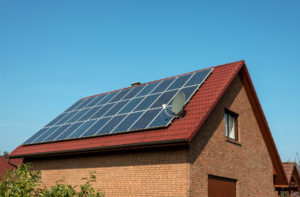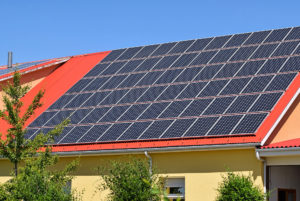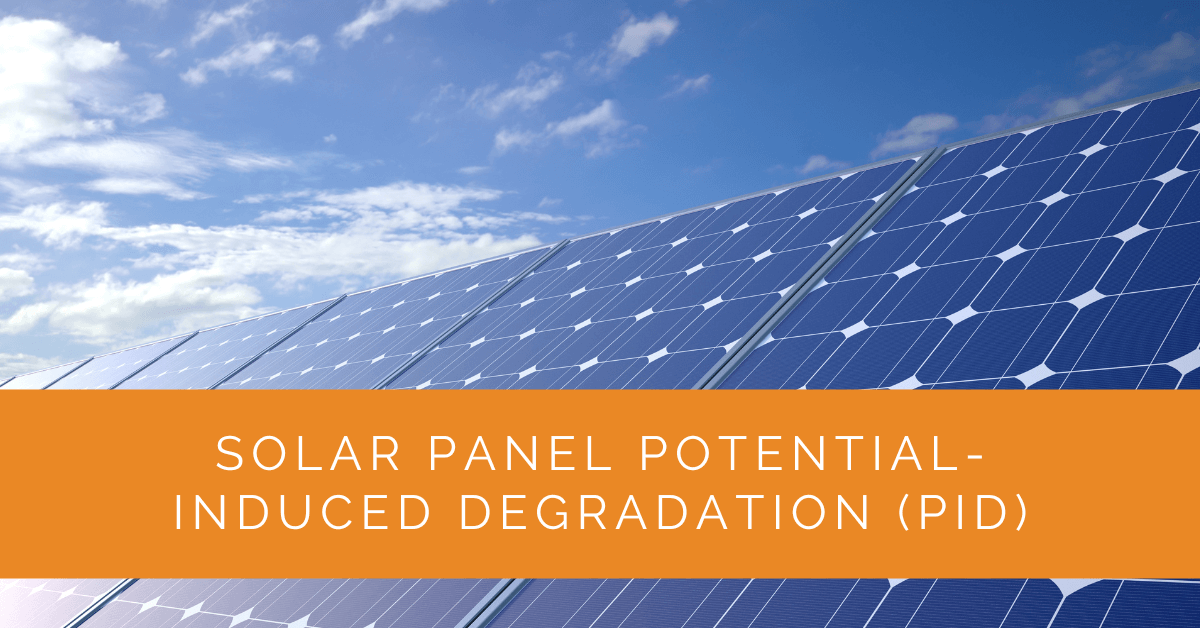Solar energy, harnessed through photovoltaic (PV) modules, has revolutionized the renewable energy landscape. However, a persistent challenge, Potential-Induced Degradation (PID), demands attention as the PV industry expands. This article delves into the intricate details of PID, examining its causes, effects, and, most importantly, strategies for mitigation.
Contents
- 1 Key Takeaways
- 2 What is PID?
- 3 Causes of PID
- 4 Detecting PID Early
- 5 Effects of PID on PV Module Performance
- 6 Mitigation Actions
- 7 Maintenance and Monitoring
- 8 Case Study: Effective Mitigation of PID in a Residential Solar Installation
- 9 Expert Insights From Our Solar Panel Installers About Potential-Induced Degradation (PID)
- 10 Experience Solar Excellence with Us!
- 11 Conclusion
Key Takeaways
- Potential-induced degradation (PID) is a critical concern for solar panel owners, affecting PV module efficiency due to high temperature and humidity.
- Early detection of PID through techniques like electroluminescence imaging and ongoing monitoring is crucial to minimize power loss and financial impacts.
- Mitigation actions, including selecting PID-resistant modules, proper installation, and environmental management, can significantly reduce the risk and effects of PID in photovoltaic systems.
What is PID?
Exploring the Concept of PID
Potential-induced degradation (PID) is a phenomenon that adversely affects the performance of PV modules over time. It occurs when there is an electrical potential difference between the solar module and the ground, leading to a negative voltage at the solar cell level. This negative potential can result in power losses and significantly impact the overall efficiency of the entire PV system.
PID in the Context of Solar Energy Generation
Understanding PID is crucial in the context of solar energy generation. The process begins with the interaction of photons from sunlight with the semiconductor material, typically silicon, within a solar cell. When sunlight strikes the cell, it excites electrons, creating an electric current. This current, in turn, generates voltage and power, which can be harnessed for electricity.
However, the negative voltage induced by PID creates a challenging scenario. It’s essential to comprehend how PID occurs to effectively manage its impact on photovoltaic modules.

Causes of PID
Factors Contributing to PID
High Temperature
High temperatures can exacerbate PID effects. Solar modules are exposed to varying temperatures, and as they heat up, the voltage difference between the module and the ground increases, amplifying the potential for degradation. This makes regions with scorching climates more vulnerable to PID.
Humidity
Humidity plays a significant role in PID occurrence. In areas with high humidity levels, moisture can penetrate the solar module, leading to leakage currents and contributing to PID. Understanding the relationship between humidity and PID is crucial for mitigation.
Module Design and Materials
The design and materials used in PV modules can influence their susceptibility to PID. Some modules are more PID-resistant than others, thanks to innovative engineering and materials like anti-PID coatings. When selecting solar panels, considering the module’s design and materials is essential in minimizing PID risk.
Detecting PID Early
Methods and Techniques for Detecting PID
Detecting PID in its early stages is vital for preventing further degradation. One effective method is electroluminescence imaging, which can reveal PID-affected areas within a solar module. Routine inspections using this technique can pinpoint trouble spots and help prevent more extensive damage.
Indicators of PID in Photovoltaic Systems
Understanding the indicators of PID is essential for PV system owners. Monitoring voltage and power output can help identify PID’s presence. Decreased power production and abnormal voltage behavior are red flags that should prompt further investigation. Regular checks of these parameters are vital in catching PID early and taking corrective actions.
Effects of PID on PV Module Performance
How PID Impacts the Efficiency of Photovoltaic Modules
The effects of PID on PV modules can be profound. As the negative voltage accumulates, it can lead to power loss, reducing the overall efficiency of the module. This translates to decreased energy production and potential financial losses for PV system owners.
PID’s impact on PV modules’ efficiency is sometimes reversible. When the solar module is no longer under the influence of a negative potential, it can recover to some extent. However, the extent of recovery varies and depends on several factors, including the severity and duration of PID exposure.
Real-World Consequences for Solar Panel Owners
For solar panel owners, the financial impact of PID can be significant. Reduced energy output means longer payback periods for their PV investments. Recognizing the financial consequences of PID underscores the importance of mitigation actions.

Mitigation Actions
Strategies for Preventing PID
Choosing PID-Resistant PV Modules
Some modules are specifically designed to resist PID in the ever-evolving PV industry. Opting for PID-resistant options can significantly mitigate potential degradation issues when investing in solar panels. These modules are engineered to minimize the negative effects of PID and ensure long-term performance.
Installation Best Practices
Proper installation techniques can reduce the risk of PID. Grounding and polarization practices, such as ensuring the negative pole of the PV system is at ground potential, can help prevent the occurrence of PID. Additionally, installing PV modules in locations with lower humidity and moderate temperatures can reduce PID risk.
Environmental Factors to Consider
Environmental factors like humidity and temperature should be carefully considered during PV system planning. Shading and cooling mechanisms can help maintain optimal operating conditions and reduce PID impact. Location-specific considerations are vital in creating PID-resistant PV systems.
Maintenance and Monitoring
Importance of Ongoing Monitoring for PID
Continuous monitoring of PV systems is essential for PID prevention. Regular inspections and advanced monitoring software can help detect and address PID early, minimizing its impact. Ongoing monitoring ensures that any PID-related issues are promptly identified and addressed.
Routine Maintenance to Prevent PID
Maintenance practices like cleaning and ensuring proper grounding should be part of a PV system owner’s routine. These preventive measures can extend the lifespan of PV modules and reduce the risk of PID. Regularly cleaning modules to remove dirt and debris and ensuring proper electrical grounding can prevent PID from developing.
Monitoring Software and Systems for PID Detection
Investing in monitoring software and systems capable of detecting PID can provide real-time data on module performance. This proactive approach allows for timely mitigation actions, preserving the efficiency of the PV system. Advanced monitoring tools can help pinpoint PID-affected areas and facilitate corrective measures.
Case Study: Effective Mitigation of PID in a Residential Solar Installation
Background
At Solar Panels Network USA, we prioritize the efficiency and longevity of photovoltaic (PV) systems. Potential-Induced Degradation (PID) is a well-known challenge in the solar industry, often leading to reduced energy output and financial losses. This case study explores a successful residential solar installation where we effectively mitigated PID, ensuring optimal performance and customer satisfaction.
Project Overview
We were approached by a homeowner concerned about the potential impacts of PID on their planned solar installation. The client’s primary goal was to invest in a reliable PV system that would provide consistent energy output over the years. Understanding the critical importance of addressing PID, we devised a comprehensive plan that incorporated preventive measures and ongoing monitoring.
Implementation
- Selecting PID-Resistant Modules: We started by selecting high-quality, PID-resistant PV modules. These modules are engineered with advanced materials and coatings designed to withstand the electrical stresses that typically lead to PID. By opting for these robust modules, we set a strong foundation for the system’s longevity.
- Proper Installation Techniques: Our team followed best practices in installation, including meticulous grounding and polarization methods. Ensuring the negative pole of the PV system was at ground potential was a key step in preventing PID. Additionally, we strategically placed the modules in areas with lower humidity and moderate temperatures, significantly reducing the environmental factors that contribute to PID.
- Routine Monitoring and Maintenance: To keep PID at bay, we implemented a rigorous monitoring schedule. Using state-of-the-art electroluminescence imaging, we conducted regular inspections to detect any early signs of PID. This proactive monitoring allowed us to address potential issues before they could impact the system’s efficiency. Routine maintenance, such as cleaning the modules and checking electrical connections, was also integral to our approach.
Results
- Consistent Energy Production: The homeowner reported stable and reliable energy output from the PV system, with no significant power losses attributed to PID.
- Enhanced System Longevity: By using PID-resistant modules and adhering to best practices, we ensured the system maintained high performance over time, extending its useful life.
- Financial Savings: Preventing PID resulted in significant financial savings for the homeowner by avoiding potential losses in energy production and reducing maintenance costs.
- Increased Customer Satisfaction: The client expressed high satisfaction with the PV system’s performance, highlighting the importance of our comprehensive approach to mitigating PID.
Summary
This case study highlights the importance of addressing Potential-Induced Degradation from the outset of a solar installation project. At Solar Panels Network USA, we utilize advanced materials, precise installation techniques, and continuous monitoring to safeguard against PID. Our commitment to excellence ensures that our clients enjoy maximum energy output and return on investment from their PV systems.
Expert Insights From Our Solar Panel Installers About Potential-Induced Degradation (PID)
Our installation approach always includes the selection of PID-resistant modules and proper grounding techniques to minimize PID risks. Regular monitoring is also a key aspect to ensure the long-term efficiency of the system.
Senior Solar Installer
Identifying PID early through methods like electroluminescence imaging has saved our clients from significant power losses. This proactive approach helps us maintain optimal system performance and client satisfaction.
Lead Solar Technician
Proper installation and environmental management are crucial in mitigating PID. We make sure to install PV systems in locations with minimal humidity and moderate temperatures to reduce the potential for degradation.
Chief Solar Engineer
Experience Solar Excellence with Us!
Trust in Solar Panels Network USA, where our seasoned experts deliver top-quality solar solutions for homes and businesses nationwide. With a legacy of countless successful installations and a commitment to sustainable energy, we’re your reliable partner in the solar journey. Ready for a brighter, eco-friendly future? Call us now at (855) 427-0058 and harness the power of the sun!
Conclusion
In the rapidly growing field of renewable energy, PID remains a challenge the PV industry continues to address. Recognizing PID’s causes, effects, and mitigation strategies is vital for both PV module manufacturers and system owners. By making informed decisions, embracing PID-resistant technologies, and implementing best practices in installation, environmental management, and ongoing maintenance, the solar industry can mitigate the impact of PID and continue to thrive in its pursuit of harnessing the power of the sun for a sustainable future.
About the Author
Solar Panels Network USA stands at the forefront of solar energy solutions, driven by a team of seasoned solar engineers and energy consultants. With over decades of experience in delivering high-quality solar installations and maintenance, we are committed to promoting sustainable energy through customer-centric, tailored solutions. Our articles reflect this commitment, crafted collaboratively by experts to provide accurate, up-to-date insights into solar technology, ensuring our readers are well-informed and empowered in their solar energy decisions.

